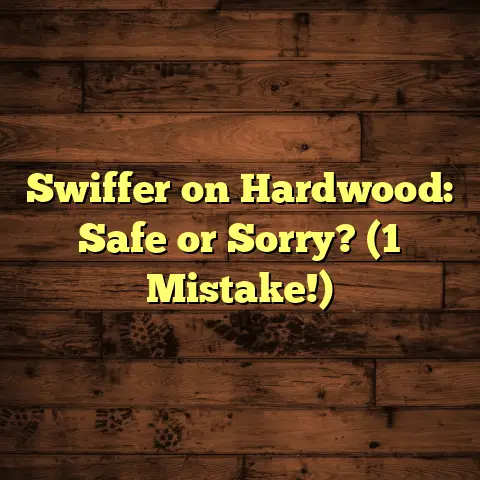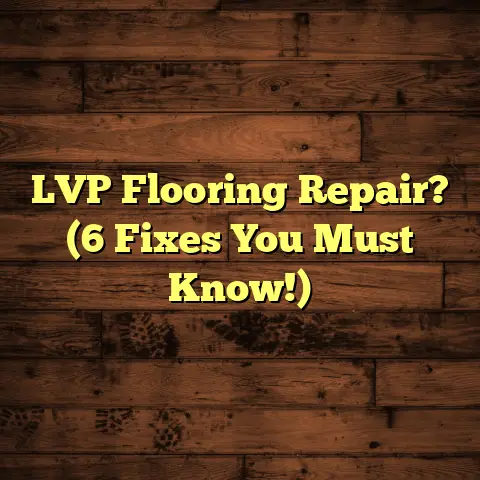Rejuvenate on Hardwood: How Long? (2 Warnings!)
Like you, I understand the dilemma of wanting to breathe new life into those beautiful wooden surfaces without accidentally making things worse.
Do you ever walk into your home and feel like your hardwood floors have lost their sparkle? Do you remember when they used to gleam under the sunlight, adding warmth to your space?
If you’re nodding along, you’re in the right place.
In this article, we’re diving deep into hardwood floor rejuvenation. We’ll cover how long it really takes, the best methods to use, and, most importantly, the two critical warnings you absolutely need to know before you even think about picking up a sander or a bottle of floor restorer.
Trust me, knowing these warnings can save you a ton of time, money, and heartache. So, let’s get started!
1. Understanding Hardwood Floors
Before we jump into rejuvenation, let’s get on the same page about hardwood floors.
1.1 Composition and Types of Hardwood
Hardwood floors aren’t just planks of wood; they’re complex materials with unique characteristics. The type of wood significantly impacts how it reacts to wear and tear and, consequently, how you should approach rejuvenation.
Here’s a quick rundown of some common hardwoods:
-
Oak: The workhorse of hardwood flooring. Oak is durable, readily available, and relatively affordable. It has a prominent grain pattern and takes stain well. White oak is more water-resistant than red oak.
-
Maple: Known for its smooth, subtle grain and light color. Maple is harder than oak, making it a good choice for high-traffic areas. However, it can be tricky to stain evenly.
-
Cherry: A luxurious option with a rich, reddish-brown hue that deepens with age. Cherry is softer than oak and maple, so it’s more prone to scratches and dents.
-
Hickory: One of the hardest and most durable domestic hardwoods. Hickory has a bold grain pattern and a rustic look.
-
Walnut: A beautiful dark wood with a distinctive grain. Walnut is softer than oak and can be more expensive.
How does the wood type impact rejuvenation?
-
Hardness: Softer woods like cherry require a gentler approach to sanding to avoid damaging the surface.
-
Grain Pattern: The grain pattern affects how stain is absorbed. Open-grained woods like oak take stain more readily than closed-grained woods like maple.
-
Original Finish: Knowing what type of finish was originally applied (e.g., polyurethane, oil-based, water- based) is crucial for choosing compatible rejuvenation products.
I always tell my clients, “Know thy wood!” Understanding what you’re working with is half the battle.
1.2 Common Issues with Hardwood Floors
What makes us even consider rejuvenation?
Well, hardwood floors aren’t invincible. Over time, they face a barrage of daily wear and tear. Here are some common issues I see all the time:
-
Scratches: The most common complaint. Scratches can range from minor surface imperfections to deep gouges.
-
Dullness: Over time, the finish on hardwood floors can become dull and lackluster, losing its original shine.
-
Water Damage: Spills, leaks, and high humidity can cause water damage, leading to warping, cupping, and staining.
-
Fading: Exposure to sunlight can cause hardwood floors to fade, especially in areas near windows.
-
Gaps: Seasonal changes in humidity can cause wood to expand and contract, leading to gaps between planks.
-
Stains: Pet stains, food spills, and other accidents can leave unsightly stains on hardwood floors.
1.3 Importance of Maintenance
Let’s talk prevention!
The best way to avoid extensive rejuvenation is to maintain your hardwood floors properly.
Here are some essential maintenance tips:
-
Regular Cleaning: Sweep or vacuum regularly to remove dirt and debris that can scratch the finish.
-
Damp Mopping: Use a damp mop with a pH-neutral wood floor cleaner to remove surface dirt and grime. Avoid over-wetting the floor.
-
Use Rugs and Mats: Place rugs and mats in high-traffic areas and at entrances to protect the floor from wear and tear.
-
Avoid Harsh Chemicals: Don’t use abrasive cleaners, bleach, or ammonia, as they can damage the finish.
-
Trim Pet Nails: Keep your pet’s nails trimmed to prevent them from scratching the floor.
-
Use Furniture Pads: Place felt pads under furniture legs to prevent scratches and dents.
-
Control Humidity: Maintain a consistent humidity level in your home to prevent wood from expanding and contracting.
I tell my clients that regular maintenance is like brushing your teeth – it’s a small effort that pays off big time in the long run.
2. The Rejuvenation Process
Okay, so you’ve assessed your floors, and they need some love. Let’s dive into the rejuvenation process.
2.1 Assessing the Condition of Your Floors
Before you start, take a good, hard look at your floors. What are you dealing with?
Here’s a checklist to guide you:
-
Scratch Depth: Are the scratches superficial (only in the finish) or deep (penetrating the wood)?
-
Dullness Level: Is the floor uniformly dull, or are there still some areas with shine?
-
Water Damage Extent: Are there any signs of warping, cupping, or staining?
-
Finish Type: Can you identify the type of finish that was originally applied? (This might require some research or consulting with a professional.)
-
Overall Wear and Tear: How much traffic does the area get? Are there any areas with excessive wear?
Tools for Assessment:
-
Bright Light: Use a flashlight or work light to highlight scratches and imperfections.
-
Magnifying Glass: A magnifying glass can help you examine the finish and identify the type of damage.
-
Moisture Meter: If you suspect water damage, a moisture meter can help you determine the moisture content of the wood.
Based on your assessment, you can determine which rejuvenation method is most appropriate.
2.2 Preparation for Rejuvenation
Preparation is key! Rushing into rejuvenation without proper prep is like trying to bake a cake without preheating the oven – it’s just not going to work.
Here are the steps you should take:
-
Clear the Room: Remove all furniture, rugs, and other items from the area.
-
Clean the Floor: Thoroughly clean the floor to remove dirt, dust, and debris. Sweep, vacuum, and then damp mop with a pH-neutral wood floor cleaner.
-
Remove Old Finish (If Necessary): If you’re planning to refinish the floor, you’ll need to remove the old finish by sanding. (More on that later.)
-
Protect Adjacent Areas: Cover baseboards, walls, and other surfaces with painter’s tape and plastic sheeting to protect them from dust and debris.
-
Ventilation: Ensure adequate ventilation by opening windows and doors.
2.3 Rejuvenation Methods
Alright, let’s get to the fun part – the actual rejuvenation!
There are several methods you can use, each with its own pros and cons.
Refinishing: The Full Monty
Refinishing involves sanding down the old finish, staining (if desired), and applying a new finish. It’s the most intensive rejuvenation method, but it can completely transform your hardwood floors.
Here’s the process:
-
Sanding: Use a drum sander or orbital sander to remove the old finish and smooth out imperfections. Start with a coarse grit sandpaper and gradually move to finer grits.
-
Staining (Optional): Apply a stain to change the color of the wood. Be sure to test the stain in an inconspicuous area first to ensure you like the color.
-
Finishing: Apply several coats of a polyurethane or other durable finish. Allow each coat to dry completely before applying the next.
Timeframes:
-
Sanding: 1-3 days, depending on the size of the area and the condition of the floors.
-
Staining: 1 day (including drying time).
-
Finishing: 2-3 days (including drying time between coats).
Pros:
-
Completely restores the look of hardwood floors.
-
Removes deep scratches and imperfections.
-
Allows you to change the color of the wood.
Cons:
-
Time-consuming and labor-intensive.
-
Requires specialized equipment and skills.
-
Creates a lot of dust.
Using Rejuvenating Products: The Quick Fix
Rejuvenating products are designed to restore shine and protect hardwood floors without sanding. They’re a great option for floors with minor scratches and dullness.
Types of Rejuvenating Products:
-
Restorers: These products fill in minor scratches and add a protective layer to the finish.
-
Polishes: Polishes enhance the shine of the floor and provide a temporary protective coating.
-
Cleaners: Specialized wood floor cleaners can remove dirt and grime without damaging the finish.
Application Process:
-
Clean the Floor: Thoroughly clean the floor to remove dirt and debris.
-
Apply the Product: Apply the rejuvenating product according to the manufacturer’s instructions.
-
Allow to Dry: Allow the product to dry completely before walking on the floor.
Timeframes:
-
Cleaning: 30 minutes to 1 hour.
-
Application: 30 minutes to 1 hour.
-
Drying: 1-2 hours.
Pros:
-
Quick and easy to apply.
-
Doesn’t require specialized equipment.
-
Affordable.
Cons:
-
Doesn’t remove deep scratches or imperfections.
-
Provides only a temporary fix.
-
May not be compatible with all types of finishes.
DIY vs. Professional Services: Which is Right for You?
Should you tackle hardwood floor rejuvenation yourself, or should you hire a professional?
DIY:
Pros:
-
Saves money.
-
Allows you to control the process.
Cons:
-
Time-consuming and labor-intensive.
-
Requires specialized equipment and skills.
-
Risk of making mistakes.
Professional Services:
Pros:
-
Ensures a high-quality result.
-
Saves time and effort.
-
Reduces the risk of mistakes.
Cons:
-
More expensive.
-
Requires finding a reputable contractor.
I always advise clients to weigh the pros and cons carefully before making a decision. If you’re comfortable with DIY projects and have the necessary skills and equipment, then rejuvenating your hardwood floors yourself can be a rewarding experience. However, if you’re not confident in your abilities or don’t have the time, hiring a professional is usually the best option.
3. How Long Does the Rejuvenation Process Take?
Let’s get down to brass tacks: How long will all this take?
3.1 Timeframes for Different Methods
Here’s a quick summary of the timeframes for each method:
-
Refinishing: 4-7 days (including sanding, staining, and finishing).
-
Using Rejuvenating Products: 2-4 hours (including cleaning, application, and drying).
3.2 Factors Affecting Duration
Several factors can influence how long the rejuvenation process takes:
-
Size of the Area: Larger areas will take longer to sand, stain, and finish.
-
Condition of the Floors: Floors with deep scratches or water damage will require more extensive sanding.
-
Type of Finish: Some finishes require longer drying times than others.
-
Environmental Factors: Humidity and temperature can affect drying times.
-
Your Skill Level: If you’re a beginner, it will likely take you longer to complete the project than an experienced professional.
3.3 Realistic Expectations
It’s important to have realistic expectations about the outcomes of your rejuvenation efforts.
While refinishing can completely transform your hardwood floors, using rejuvenating products will only provide a temporary fix.
Also, keep in mind that results may vary depending on the type of wood, the type of finish, and the condition of the floors.
4. Warnings and Pitfalls
Okay, time for the most important part: the warnings! I’ve seen these mistakes happen time and time again, and I want to make sure you don’t fall into the same traps.
4.1 Warning #1: Overzealous Rejuvenation
It’s tempting to go all-out when rejuvenating your hardwood floors, but excessive or improper rejuvenation efforts can actually do more harm than good.
Here are some common mistakes to avoid:
-
Over-Sanding: Sanding too aggressively can remove too much wood, leading to unevenness and damage.
-
Using Incompatible Products: Using rejuvenating products that are not compatible with your floor’s finish can cause discoloration, peeling, and other problems.
-
Applying Too Much Product: Applying too much rejuvenating product can leave a sticky residue that’s difficult to remove.
-
Skipping Preparation: Skipping essential preparation steps like cleaning and removing old finish can lead to poor results.
I once had a client who tried to refinish his hardwood floors without any prior experience. He used a drum sander and ended up gouging the floor in several places. He then tried to fix the gouges by applying wood filler, but it didn’t match the color of the wood. In the end, he had to hire a professional to redo the entire floor, which cost him even more money.
4.2 Warning #2: Ignoring Underlying Issues
It’s easy to focus on the surface appearance of your hardwood floors and ignore underlying problems. However, addressing only the surface without fixing underlying issues can lead to disappointing results and costly repairs down the road.
Here are some underlying issues to look out for:
-
Moisture Issues: High humidity, leaks, and spills can cause water damage, leading to warping, cupping, and staining.
-
Structural Damage: Uneven subfloors, loose floorboards, and other structural problems can cause hardwood floors to creak, sag, and become damaged.
-
Insect Infestations: Termites, carpenter ants, and other insects can damage hardwood floors from the inside out.
I had another client who was trying to sell her house. She decided to rejuvenate her hardwood floors to make them more appealing to potential buyers. She used a rejuvenating product to restore the shine, but she didn’t address the fact that there was a leaky pipe under the floor. The leaky pipe caused water damage, leading to mold growth and structural problems. The potential buyers discovered the problem during the home inspection, and they backed out of the deal.
Conclusion: Restoring Your Hardwood Floors Wisely
Rejuvenating your hardwood floors can breathe new life into your home, but it’s essential to approach the process with careful planning and awareness of potential pitfalls.
Remember to assess the condition of your floors, choose the right rejuvenation method, and avoid overzealous rejuvenation and ignoring underlying issues.
By following these tips, you can achieve the best results and enjoy your beautiful hardwood floors for years to come.
Happy rejuvenating!





